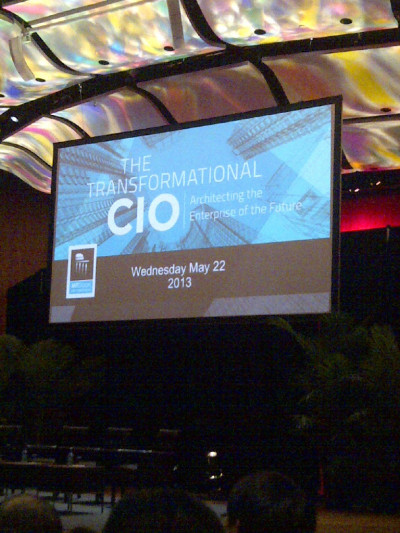MIT Sloan has for 10 years held a “CIO Symposium.” This is an opportunity for thought leaders in industry and academia to compare notes and contemplate the future. This year’s theme, “Architecting the Enterprise of the Future.”

My synopsis of the one day session? IT is DEAD. The CIO title often referred to as the Chief Information Officer (not the Chief Investment Officer of financial services firms) really means Career Is Over.
Many things in IT have died over my career. The mainframe was declared a dinosaur in the 70s and 80s as “distributed computing” took over. Companies like Prime, Data General, and Digital Equipment Corporation were poised to dethrone International Business Machines (IBM) as the leader of computing.
Who remembers Prime, Data General, and Digital Equipment Corporation (DEC)? Each of these companies was a once proud Massachusetts computer company, and IBM thrives.
I left the session with a distinct feeling of coming from a wake, where memories of the dearly departed were shared.
Sage advice like “IT needs to align with the business” has been a mantra for decades. “IT needs to speak in business terms and not IT terms” is an evergreen comment. I was live tweeting from the audience, and at one point was challenged by a friend:
@glkelley #mitcio this is not news. See “Undercover Boss”. IT should doublejack with a phonerep, process a backoffice tx, use the website.
— Ray Chang (@rjchang) May 22, 2013
“The Use of Power and Influence During the Process of Innovation” was a theme of an early session.
My tweeting shows some good soundbites, and perhaps nothing new:
@glkelley Really like #HIPPO. Might start using the term more often!
— SearchCIO.com (@searchCIO) May 22, 2013
“Big data” got a bit more of a reaction:
Indeed. RT @glkelley: Big data is a Management Revolution. #MITCIO twitter.com/glkelley/statu…
— Bob Madaio (@bmadaio) May 22, 2013
And some reaction was bittersweet:

As an IT professional, do I think IT is dead? No (although I did tell my son not to get into the business, and he did anyway.) IT needs to evolve or perish. (This isn’t new either.)
IT is seeing a repeat of the mainframe death knell because so many business lines can now “do their own thing.” Salesforce.com has revolutionized the way sales teams work, and business lines feel empowered. Are there issues around privacy and “islands of automation?” You bet. And many organizations are balancing agility with regulations and are being successful.
I’m going to submit “islands of automation” was one of the cries in the era of Prime, Data General, and Digital Equipment Corporation. It’s déjà vu all over again.
What drives business lines to do these projects is IT is viewed as an obstacle, not an enabler.
Georgia Papathomas, VP and CIO of J&J Pharmaceuticals, had some great insights in a session, “Driving Innovation and Managing Expectations:”
- “Everything in IT takes too long,”
- “There is only a business strategy, no IT Strategy.” It’s an IT roadmap at J&J. This is a subtle powerful shift.
- We are using technology to evolve to a Health Care company, from a Product Company. And that doesn’t mean it’s IT leading the charge.
The session “Strategic Agility through IT: Harnessing the Convergence of Data, Analytics and the Cloud” offered some jewels like:
- Agile methodology not just for IT; for business unit as well (somehow that doesn’t sound like business speak.”
- “It used to be work had the best technology, and not home. It’s switched. And the people managing tech need to understand,” offered Michael Relich, EVP, CIO and Strategic Planning for Guess
- Sharing data between private clouds (like fraud data) is a large opportunity for companies
The award for the best stream of soundbites in the session, “The Evolving Cloud Agenda” went to Scott Blanchette, SVP of Information and Technology Services at Vanguard Health Systems:
- Security and Privacy regulations most significant barrier to cloud
- We put the appropriate (security) wrappers around data in the cloud.
- Buying equipment is cheap today; even EMC. (Crowd knowingly laughs)
- Don’t ask your barber if you need a haircut yielded don’t ask a hardware vendor if you should go cloud from @ValaAfshar
- Processing speed is accelerating faster than collection of health care data
- We put governance in place for people who come up with the best ideas. “The best ideas will come from someplace that we don’t expect.”
My view of the best session, the one giving me the most reason for hope, was put on by Andrew McAfee, Principal Research Scientist at the MIT Sloan School of Management. Sadly he was on at the very end.
He posits the steam engine propelled humankind as first machine age and we are on the precipice of 2nd machine age. He sees the following CODE:
- Cyborg - new man/machine combinations will propel us, combining human/digital contribution
- Open - organizations will be more open. The smartest people work somewhere else. With enough eyes the bugs are small
- Data-Driven - rigorous analytical approach is driving economy. (Think a restaurant owner can identify theft)
- Evolving - how quickly innovation is happening and disruption happening.

Whether Information Technology stays in the “C” suite or not, it is clear IT can study the past, and use this knowledge as a way to leapfrog (and not simply repeat.)
Gary L Kelley’s twitter feed from the MIT CIO Symposium and other extraneous topics can be viewed at https://twitter.com/glkelley